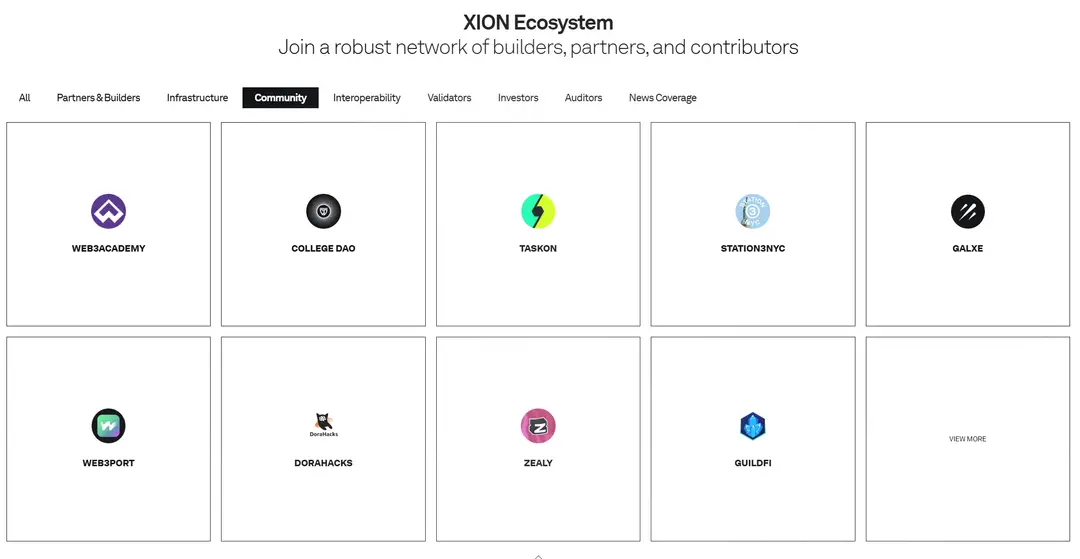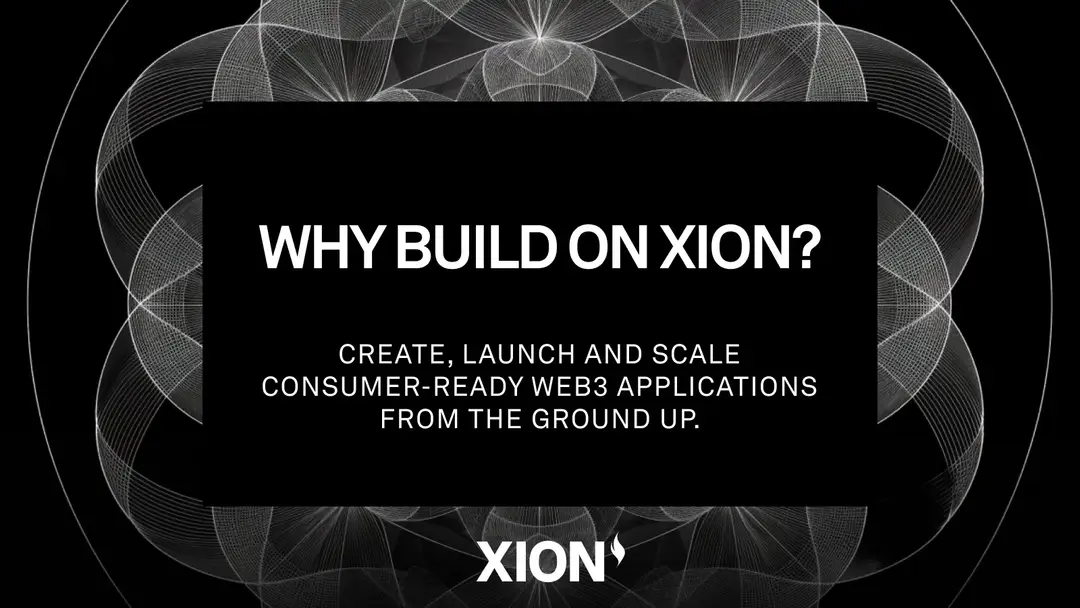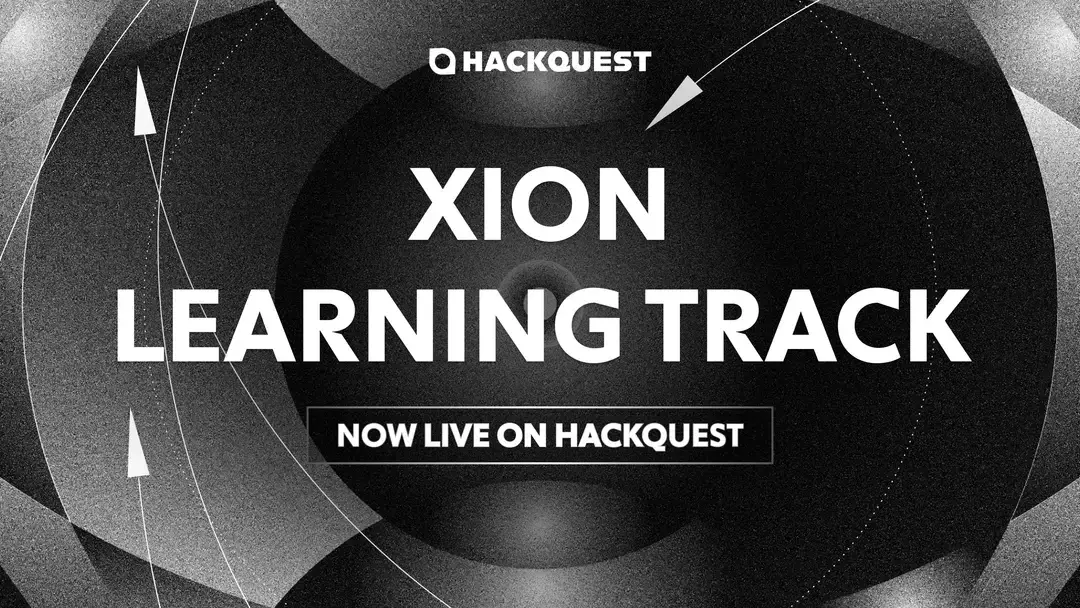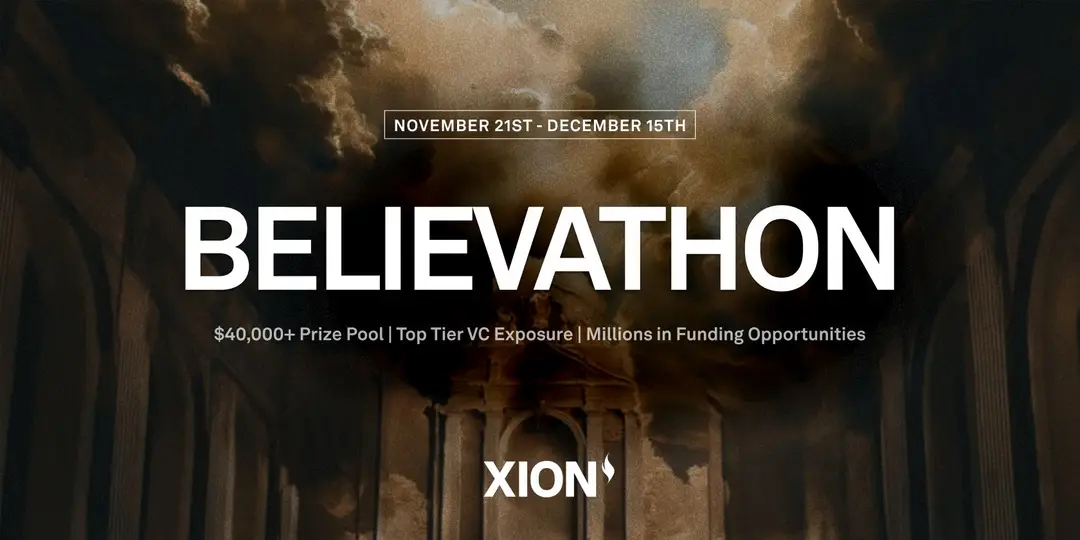Believing in Something: XION AMA Recap with Burnt Banksy, Founder of XION

With the launch of the XION Learning Track on HackQuest, we hosted an insightful AMA session featuring Harry Zhang, Co-founder of HackQuest; Burnt, Founder of XION; and Ze, Head of Ecosystem at XION. The conversation explored the origins of XION and the Burnt Movement, its distinctive approach to empowering builders, strategies for overcoming industry barriers, and initiatives like the XION Believathon and Learning Track. Together, the speakers shared their vision for fostering innovation, supporting developers, and building a vibrant Web3 ecosystem.
(Click here for the full AMA playback)
Key Takeaways

Harry Zhang:
We’re excited to celebrate the launch of the XION Learning Track and the Believathon, opening new opportunities for builders to innovate and shape the future of this space.
A lot of the community heard of you and the project because you burnt that piece of Banksy. I was curious, what inspired you to do that and initiate a whole XION and Burnt movement?
Burnt:
Yeah, a lot of it just started with how absolutely bad that process was. Number one, how bad it was for people who are already technical like myself to mint an NFT.
But then also I couldn’t really market it to normal people because the assumption in that scenario is that you already have Ethereum. You’ve done your KYC, moved it to a MetaMask, have a place to hold it, and probably a ledger for that amount of money. There’s a lot of assumptions there that come with running an application in crypto.
Burnt:
And XION started because I just want people to use the things we do. I want to keep doing things like the burnt Banksy stuff, but it doesn’t make sense because I’m only marketing it to 15 people.
Harry Zhang:
Ever since the movement started, there’s been this idea of believing in something. Every post has this belief circulating.
To piggyback on the previous question, where does this come from, and what is the message trying to convey to folks who may not fully grasp it?
Burnt:
What do you mean? It’s simple. It’s right there.
A lot of what we’re doing is aligned with the crypto ethos—believing in a decentralized world, transparency, and cutting out the middleman. To latch onto something, believe in it, and see it through is fundamental.

XION’s Unique Proposition
Harry Zhang:
I remember earlier this year in September, attending one of the conferences, Vitalik mentioned we’re no longer early to crypto, but we’re early to crypto being usable. One of XION’s taglines is about chain abstraction—pushing mass adoption and enabling users, devs, and builders to easily build and ship products people will use.
Harry Zhang:
How would you pitch XION not only to retail users but also to devs, builders, and founders in the ecosystem contemplating building on XION?
Burnt:
A lot of different communities there, right? We are the first and only walletless L1, introducing proof of abstraction relatively soon.
The idea is to hit mainstream adoption by meeting users where they are. We’ve already proven this by removing wallets, the largest friction point.
Additionally, culturally redefining terms—so things aren’t called NFTs—is key. A year ago, things were different. Now, we’ve had 50 million transactions in the testnet with 3–5 million users. It’s not a dream anymore. We’re pitching a path, showing proof and direction. After that, it’s pretty simple.

Addressing Builder Challenges
Harry Zhang:
Makes sense. XION is on a mission to make ownership accessible to everyone, removing obstacles through chain abstraction and everything being built on the technical and community sides.
I know there are a couple of programs in the works. Could you elaborate on some of the barriers builders and founders face and how XION addresses them differently compared to other ecosystems?
Burnt:
I think they’re just different projects, quite frankly. The projects we talk to end up being rather bespoke.
For example, we’re working with a project partnered with Samsung to be pre-downloaded on Samsung smart TVs. You can’t really do that on any chain because you need a wallet, and it’s pretty miserable. But with smart contract accounts, that issue doesn’t exist. That’s a very XION-specific solution.
Another example is expanding the total addressable market. Once we say our market isn’t just crypto but anyone with an email or a social account, the scope becomes massive.
When it comes to other ecosystems, like a DEX or lending protocol, we’re not really focusing on those projects. No hate—it’s just not our focus. So it’s hard to compare directly, but our solutions are tailored to these unique use cases.

Community and Advocate Programs
Harry Zhang:
One of the programs I’m very excited about—outside of the learning and building aspects—is the advocate or ambassador program.
How would you describe it? Seeing XION dominating across social media and communities shows how much effort goes into investing in community, understanding users, and keeping everyone excited.
What’s the secret? How do you keep the community engaged and energized?
Burnt:
I think authenticity is the key. You see a lot of people trying to invest in community superficially, and it just doesn’t work.
The people who succeed are the ones who authentically want to be there. Decentralized projects inherently involve a lot of people—this isn’t a Web2 company with a rigid hierarchy. Instead, everyone is part of the project, supported by ambassador programs and distributions that make it clear everyone has a role.
When it comes to success, it boils down to being authentic and having fun. If you’re boring, why would anyone want to be there?
Even now, looking at our chats, it’s just awesome. The people are incredible, and it’s fun to work with them and talk about XION—or even things unrelated to XION.

Milestones and Initiatives
Harry Zhang:
One of the questions I wanted to ask was, what would you say are the major milestones on the journey of building XION? And what exciting initiatives are in the works that could be considered milestones?
Burnt:
Funny you ask—I wanted to release a roadmap this week, but there’s a lot of news coming out, and I got sidetracked. However, I’ll be releasing it soon, and I’m very excited. It’ll be an interesting take, and people are going to love it.
In terms of milestones, I think the future is ecosystem-focused. We’ve moved past the testing phase—it’s game time now. We’re fortunate to have started with 200 projects already deploying. The future of XION depends on the success of these projects.
Whether it’s the XION Ventures Academy, more Burnt Banksy-like initiatives, or other programs, every internal and external metric ties back to the ecosystem. It’s not about inflated TVL metrics; it’s about genuinely growing projects and enabling builders to succeed.
One key milestone was running one of the most successful NFT marketplaces on Solana back in the day. We realized our growth was capped due to Solana’s user base. Most of our marketing efforts went into onboarding users to Phantom, Coinbase, and Solana, which essentially made us a marketing team for these tools.
This funnel wasn’t scalable, and the friction made it nearly impossible to succeed as a project in this industry. That realization was a driving force behind creating XION, removing these barriers and simplifying access for users.
Another milestone that isn’t often talked about happened early last June. We initially considered using multi-party computation wallets as the foundation. While it was promising, we pivoted to a different approach that ultimately became the XION we see today.
Back in early June, we initially planned to implement multi-party computation wallets. The idea was to use multiple private keys to ensure security and scalability.
However, there were still issues like gas fees. Every time we worked with these providers, we ended up crashing the testnet—theirs, not ours. While that showed we were pushing boundaries and tackling significant challenges, we realized we needed a better solution.
Our CTO led us to a major technical pivot. After extensive discussions and research, we shifted to smart contract accounts on a protocol level.
This was a transformative milestone for us. It changed the company’s entire trajectory and made us question how we—and the industry—hadn’t realized this earlier. Looking back, legacy wallets will likely be seen as one of the most outdated aspects of early Web3 development.

Ecosystem and Developer Engagement
Harry Zhang:
If you had to break it down, what are the key initiatives XION is working on to sustain this growth and support founders and builders?
Burnt:
It’s all about creating a flywheel effect. For example, take the work we’re doing with HackQuest—it’s circular.
The first component is ecosystem projects. Let’s talk about Phil from EarnOS. That team is a great example of how ecosystem projects thrive within XION.
Then there’s the community, which is equally critical. When people understand and align with the vision, the distribution becomes exponential through word of mouth. Some of our top ambassadors have even brought new ecosystem projects to us. That level of organic growth is incredible. Shoutout to Dimitri—he’s been amazing.
A third, less visible but equally important aspect is friction reduction. This involves UX improvements and user adoption strategies. The better the user experience, the more users we attract. More users mean greater security and growth, which feeds back into the community and ecosystem.
This is what we’re defining as proof of abstraction—it’s the cornerstone of making everything seamless and scalable. Without this funnel of users, projects, and community, the ecosystem doesn’t work.

Building Better Tools
Harry Zhang:
Burnt, could you share your thoughts on the challenges of bringing in ecosystem-defining projects and why there are still so few consumer apps in Web3 that rival Web2?
Burnt:
Great question. It’s not just a technical issue—it’s cultural and knowledge-based. Many crypto projects are built with a crypto-native mindset, but we need to eliminate this entirely.
For instance, why do we say “connect wallet”? No one cares. Just log in. Advanced options can be available for those who want them, but for the average user, it should be seamless.
Similarly, denominating everything in dollars and integrating credit or debit cards is a no-brainer. Soon, users will be able to spend funds directly from a Web3 wallet integrated with platforms like Apple Wallet.
Innovation is happening, but those entrenched in the crypto space sometimes become numb to the user experience. The core ideas we came to crypto for—like ownership, transparency, and decentralization—are achievable. It’s just a matter of building better tools.
Harry Zhang:
What are some use cases you’re most excited about in the XION ecosystem?
Burnt:
I’m excited about EarnOS. They’re essentially working on breaking down Web2 marketing paradigms to become the Web3 equivalent of Google AdSense. Their vision is ambitious and lofty, and I can’t wait to see them progress.
Another area I’m passionate about is music. Decentralizing Spotify to give artists proper payments for their work is a really compelling idea. With advancements like zkTLS, this becomes even more feasible. Web3 companies now have the opportunity to directly compete with Web2 by providing better growth strategies—vampire attacking outdated models.
This is why it’s a focus of our current hackathon. I believe projects like these represent the next wave of consumer innovation. If we look at 2025, I predict this new consumer wave will take center stage.
The prevalence of meme coins and grifty projects emerged because of a lack of real innovation. Many projects launched with high valuations and testnet tokens but failed to deliver meaningful value.
To draw a parallel, it was innovative products like Uniswap during DeFi Summer and the rise of NFT marketplaces that brought us out of the 2019 era. However, over-financialization and exploitative practices killed that momentum.
Today, we’re in a micro-aspect of the crypto market, where new innovations are scarce. The ecosystem is saturated with lending protocols and NFT marketplaces, competing over minor percentage gains. This approach can’t sustain a $3 trillion industry—it needs breakthrough products and genuine utility.
Ze:
I think Burnt covered most of what I wanted to say.
Right now, our focus isn’t on replicating ideas from other chains. We’re not interested in copy-paste projects. Instead, we’re here to create new things—tools and innovations that can truly move the industry forward.
Burnt mentioned zkTLS, ZK email, and verification systems. Combined with reputation mechanisms, these will be game-changers in the coming years, particularly with the rise of AI. We need systems that can differentiate users and authenticate information without compromising privacy.
The next major cycle or bull run will happen when Web3 evolves into a true successor of Web2, rather than a niche “weird cousin.” This requires relevant, user-friendly applications that cater to everyday needs. Otherwise, we’ll continue servicing the same crypto-native crowd, which is short-sighted.
Our focus is on net new users, net new applications, and net new use cases. If you’re planning to build the same thing on a different chain, just don’t.

Harry Zhang:
Currently, there are 28.7 million full-time Web2 developers compared to only thousands in Web3. Even if Web3 multiplies its numbers by 5 or 10, there's still nearly a 1,000x gap.
This gap underscores the opportunity for Web2 developers to move to Web3, choose an ecosystem, and create impactful projects.
For those contemplating this shift from 29 million Web2 developers to a few thousand in Web3, what advice do you have? Burnt, let's hear from you first.
Burnt:
If your goal is to make a quick profit, this isn’t the space for you. Crypto has areas for that, but not here. We prioritize authenticity and have zero tolerance for superficial efforts.
We’re focused on building solutions that people genuinely use, not just replicating existing tools. While lending protocols and similar projects have value, our aim is to drive innovation and advance the industry.
Looking back, crypto began as Bitcoin—purely cryptocurrency. Then Ethereum and smart contracts redefined what was possible. Now, concepts like NFTs are evolving into digital assets that solve real ownership challenges.
As the market matures, we’re in a position to create meaningful crypto applications, ensuring the industry’s longevity and relevance. This is about building something enduring, not just chasing trends.
Ze:
There’s really nothing new to add here. It aligns with everything we’ve been emphasizing. The key message is critical, especially when others in the industry often take an opposite approach. We remain firm in our stance, and that’s not going to change.
Barriers to Entry
Harry Zhang:
What do you see as the primary challenges in making XION more accessible to a broader audience? How can we attract everyday users—those who are genuinely excited about the future of Web3 but might currently face barriers to entry?
Burnt:
That’s a great question. Honestly? None. That’s why XION exists.
Harry Zhang:
So, why do you think there are still gaps in dApp usage? Let’s exclude farming, wash trading, and similar activities—what about organic usage? Is it about policy, regulations, mistrust, or the perception of terms like NFT versus digital assets?
Burnt:
It’s a matter of the broader crypto landscape. It’s less about specific barriers and more about addressing what the industry as a whole has yet to solve.
Ze:
The industry has been built around ultra-complex financial instruments, which appeals to only a niche segment. Surprisingly, even among our tech-savvy generation, only 70-80% have downloaded a mobile banking app, and less than half of those use it beyond checking their balance.
Instead of focusing on fun, useful, and accessible applications, the industry has catered to the geeks—financial or otherwise. That’s where we’re missing the mark: creating solutions that the everyday person would find engaging and valuable.
Our goal is to bridge this gap and develop products that genuinely resonate with and serve a broader audience.
It’s not just about doing something slightly better or tweaking what already exists in Web3. If your project doesn’t introduce new value or solve a meaningful problem, it’s likely not worth pursuing. We focus on practical applications that enhance daily lives—whether through simplifying payments, enabling artists to benefit directly from their work, or building accessible tools.
Web3’s future relies on delivering innovative solutions that transcend the industry’s current limitations and truly enrich the user experience.

Developer Education and Onboarding
Harry Zhang:
One thing both of you touched on is that there’s nothing inherently stopping people from coming into the space—it’s about improving products and refining user experiences. Products need to solve real issues and make life easier.
What steps—beyond the XION Learning Track—has XION taken to build an infrastructure that helps onboard developers and supports them in creating products that people actually use?
Burnt:
That’s a great question. It’s a different kind of challenge. Honestly, we built everything with the idea of building for ourselves—selfishly, even. We created the platform we wanted and needed.
It’s funny when you think about it. A big part of why we’re here is because I wanted to try things that seemed absurd or ambitious.
But here’s the thing—building for ourselves wasn’t just about experimentation. It was about loving crypto and wanting to make it awesome, fulfilling the promises that crypto represents. The process became about creating something that felt personal and exciting while addressing real gaps in the space.
Ze:
Also, we’re collaborating with some great teams, including HackQuest—they’ve been incredible in this space. They’re doing a fantastic job helping bridge those gaps and making Web3 development more accessible.

Believathon and Ecosystem Building
Harry Zhang:
Let me quickly highlight the XION Learning Track, announced just two days ago. If you visit HackQuest.io/XION, you’ll find step-by-step guides to building consumer-facing projects, from PWAs to treasury contracts. These tracks help you deploy projects quickly, test user feedback, and iterate efficiently.
The Believathon is an extension of this initiative, designed to help participants move beyond learning into real-world building. It’s not a hackathon or buildathon—it’s a Believathon. After completing the learning track, you’ll be equipped to start building impactful projects with access to resources, support, and funding opportunities provided by the XION team.
Burnt:
The Believathon reflects our commitment to doing things differently in Web3. It’s not just about quick experiments—it’s about turning ideas into scalable businesses. We love wild ideas, and this is where those ideas can evolve into something lasting.
Ze:
Exactly. The Believathon is just the first step. We’re working with HackQuest and other partners to create an ecosystem where projects and builders grow with us. This pipeline extends beyond the Believathon to include accelerators, with even more ways for teams to engage and thrive.
Our ultimate goal is to be involved at every stage of a project’s journey, helping teams transform their ideas into multimillion- or even billion-dollar businesses. We love nurturing bold ideas, but it doesn’t stop there—we’re focused on helping these ideas become meaningful, sustainable ventures that align with people’s lives, passions, and futures.
This isn’t just a one-time event. It’s a platform for builders to believe in something and create businesses that inspire belief in others.
Harry Zhang:
Absolutely. So, Believathon—not a Buildathon or a Hackathon—Believathon.
To recap the timeline:
Start forming teams, building projects, and creating something that could grow into a real, investable business. Believe in something—and start building today.

Harry Zhang:
If you’re curious about what makes building on XION unique, or if you’re wondering how to incorporate features like a gasless user experience, deploy contracts on CosmWasm, or create PWAs for mobile, the XION Learning Track has plenty of resources to get you started.
The tools and code you learn through the track can be directly applied to your Believathon projects and future businesses. If you’ve built projects before, XION’s developer-friendly platform makes it even easier to start creating.
One standout section I’d highly recommend is the XION.js library. It’s especially valuable for developers familiar with Ethereum, offering a pathway to significantly enhance user experiences and transform projects into scalable businesses.
So here’s a bigger-picture question for Burnt and Ze: What advice would you give to Web2 and Web3 founders and developers interested in building on XION? How should they map out the next few months to set themselves up for success?
Burnt:
It really depends on where you are in your development cycle. If you’re at the concept stage, great—XION can help you solidify your idea. If you’re past that point, whether you’re about to fundraise, deploy on testnet, or you’re still figuring out what to build, we’re here to support you at every stage.
We’re committed to being there through the lifecycle of a project, helping teams take their ideas from the drawing board to the next level, whether it’s deploying on testnet or scaling up post-launch.
Ze:
Exactly. With HackQuest and the Believathon, we’ve established a robust pipeline. Soon, we’ll announce the details of our accelerator program, which takes projects from brainstorming to connecting with top VCs in the industry. We aim to support builders from A to Z, nurturing their journey from idea to fully-fledged business.
Harry Zhang:
To recap, here’s what the XION ecosystem offers:
XION’s end-to-end pipeline ensures that you’re supported every step of the way, whether you’re just starting or scaling up. If you have questions, feel free to reach out directly to the XION team or explore their Telegram and Discord communities.

Next Steps
Harry Zhang:
Burnt, you’ve set fire to Banksy art and even yourself in the past. What’s next on your list?
Burnt:
Nothing specific yet, but I’m always ready to set something ablaze—figuratively speaking, of course. Maybe the offices of some competitors?
Harry Zhang:
Thanks again to Burnt and Ze. To everyone interested in XION’s pipeline, feel free to connect with us on X or the XION team for guidance. Any final words for our audience?
Burnt:
Believe in something.
Ze:
Believe in something.